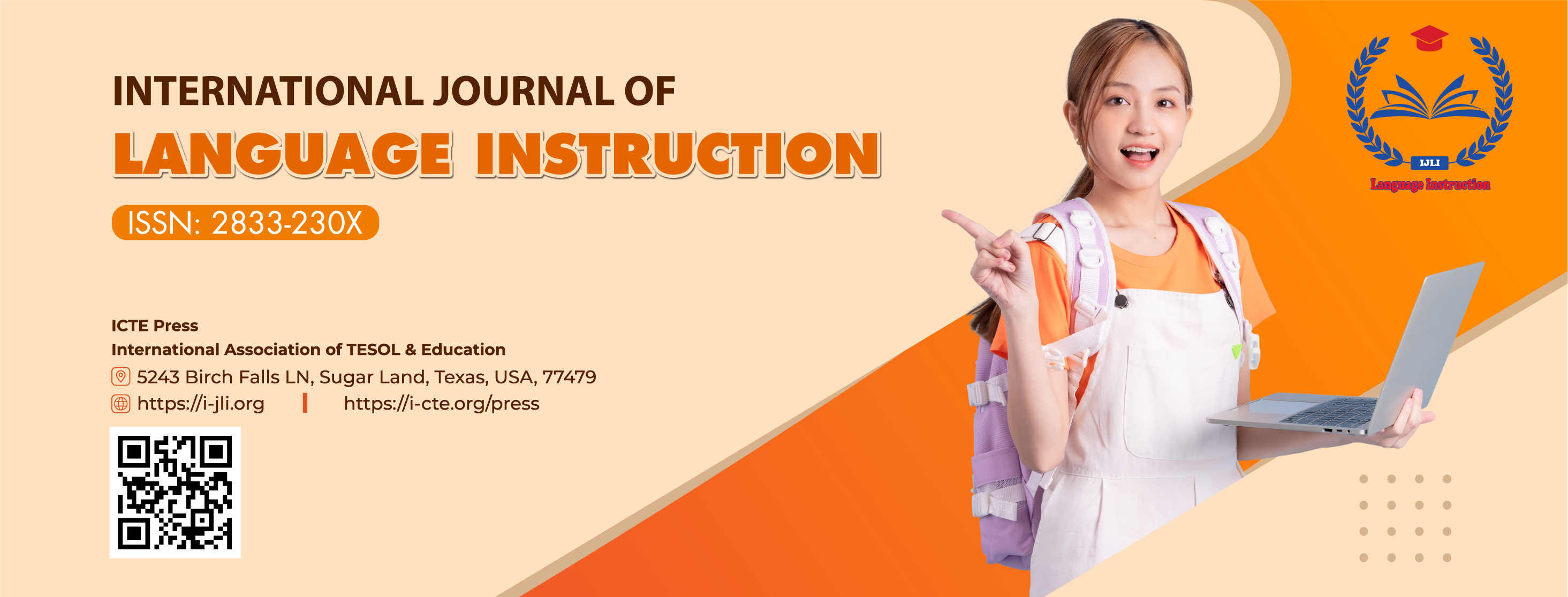The Impact of Extroversion and Introversion on EFL Students’ Second Language Acquisition
DOI:
https://doi.org/10.54855/ijli.25424Keywords:
Second Language Acquisition, extroversion and introversion, EFL students, differences in personalityAbstract
Internal factors like the personality traits of EFL students are also significant aspects that affect whether the learner’s language acquisition is successful or not. This study aims to discover the differences between language learners’ personality traits and examine the impact of personality traits (Extroversion and Introversion) on EFL students’ Second Language Acquisition. Data regarding the topic in question were collected through questionnaires from 70 first-year English majors and three English teachers at Tra Vinh University, and interviews were conducted to find out the differences between language learners in terms of personality traits. The findings revealed that first-year English majors have two common personality types in the SLA process, and these personalities significantly impact their SLA. Extroverted learners are more likely to acquire second languages well, especially in terms of speaking skills. Whereas it is difficult to know whether introverted learners acquire a second language well or not, most of the time, their learning speed is often slower than extroverted learners. In addition, the teachers from interviews also offered suggestions to support introverted learners in acquiring a second language.
References
Abalı, F. (2006). The effect of personality traits extroversion/introversion on verbal and interactive behaviors of learners (Doctoral dissertation, Bilkent University).
Brown, D. H. (2001). Teaching by principles. New York: Addison Wesley Longman, Inc
Cervantes, I. M. (2013). The role of risk-taking behavior in the development of speaking skills in ESL classrooms. Revista de Lenguas Modernas, (19). https://revistas.ucr.ac.cr/index.php/rlm/article/view/13952
Dinh, T. H. T. (2023). The effect of video clips on students’ speaking performance. International Journal of Language Instruction, 2(1), 40-50. https://doi.org/10.54855/ijli.23214
Dornyei, Z. (2005). The psychology of the language learner: Individual differences in second language acquisition. Mahwah, NJ: Lawrence Erlbaum Associates.
Douglas, B. H. (2014). Principles of Language and Teaching (6th ed.). White Plains, NY: Pearson Education.
Dulay, H. C., Burt, M. K., & Krashen, S. D. (1982). Language two. New York: OUP
Eysenck, M. W. (2004). Applied cognitive psychology: Implications of cognitive psychology for clinical psychology and psychotherapy. Journal of clinical psychology, 60(4), 393-404.
Garder, R. C., & Clément, R. (1990). Social psychology perspectives on second language acquisition. In H. Giles and W. P. Robinson (Eds.), Handbook of social psychology (pp. 495-517). Chichester, UK: John Wiley & Sons.
Guiora, A. Z., Brannon, R. C., & Dull, C. Y. (1972). Empathy and Second Language Learning 1. Language learning, 22(1), 111-130.
Hurd, S. (2002) Taking account of individual learner differences in the planning and delivery of language courses for open, distance and independent learning. The National Centre for Languages (CiLT), University of Manchester, 24-26 June 2002.
Jung, C. G. (1971). Psychological types. Princeton, NJ: Princeton University Press.
Liang, H. Y., & Kelsen, B. (2018). Influence of personality and motivation on oral presentation performance. Journal of psycholinguistic research, 47(4), 755-776.
Nussbaum, E. M. (2002). How introverts versus extroverts approach small-group argumentative discussions. The Elementary School Journal, 102(3), 183–197. http://dx.doi.org/10.1086/499699
Sharp, A. (2008). Personality and second language learning. Asian social science, 4(11), 17-25.
Suliman, F. H. A. (2014). The role of extrovert and introvert personality in second language acquisition. Proceedings of IOSR Journal of Humanities and Social Science, 20(1), 109-14.
Swain, M. (1985). Communicative competence some roles of comprehensible input and comprehensible output in its development. In S. Gass & C. Madden (Eds.), Input in second language acquisition (pp. 235-256). New York: Newbury House.
Tehrani, E. K., Vahdany, F., & Arjmandi, M. (2014). Is there any relationship between iranian efl learners'personality type and their pronunciation?. Modern Journal of Language Teaching Methods, 4(2), 75.
Truong, P. (2021). Influences of personality on students’ speaking performance. VNU Journal of Foreign Studies, 37(1). https://doi.org/10.25073/2525-2445/vnufs.4658
Tuong, H. G. B. (2022). TVU non-English majors’ attitudes toward utilizing oral presentations to overcome speaking difficulties in English classroom. International Journal of Language Instruction, 1(1), 99-119. https://doi.org/10.54855/ijli.22119
Wakamoto, N. (2007). The impact of extroversion/introversion and associated learner strategies on English language comprehension in a Japanese EFL setting: ProQuest.
Zafar, S., & Meenakshi, K. (2012). A study on the relationship between extroversion-introversion and risk-taking in the context of second language acquisition. International Journal of Research studies in language learning, 1(1), 33-40.
Downloads
Published
Issue
Section
License
Copyright (c) 2025 Thach Ngoc Mai Ly

This work is licensed under a Creative Commons Attribution 4.0 International License.
The copyright of all articles published in the International Journal of Language Instruction (ijli) remains with the Authors, i.e. Authors retain full ownership of their article. Permitted third-party reuse of the open access articles is defined by the applicable Creative Commons (CC) end-user license which is accepted by the Authors upon submission of their paper. All articles in the ijli are published under the CC BY-NC 4.0 license, meaning that end users can freely share an article (i.e. copy and redistribute the material in any medium or format) and adapt it (i.e. remix, transform and build upon the material) on the condition that proper attribution is given (i.e. appropriate credit, a link to the applicable license and an indication if any changes were made; all in such a way that does not suggest that the licensor endorses the user or the use) and the material is only used for non-commercial purposes.
Authors are able to enter into separate, additional contractual arrangements for the non-exclusive distribution of the journal's published version of the work (e.g., post it to an institutional repository, in a journal or publish it in a book), with an acknowledgment of its initial publication in this journal.











